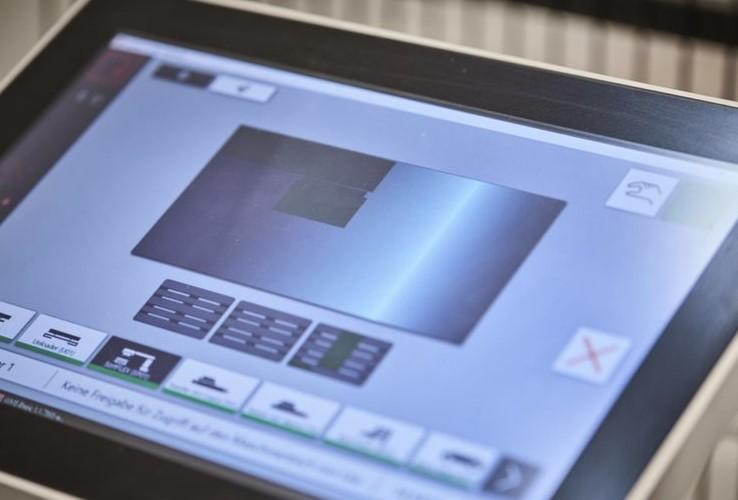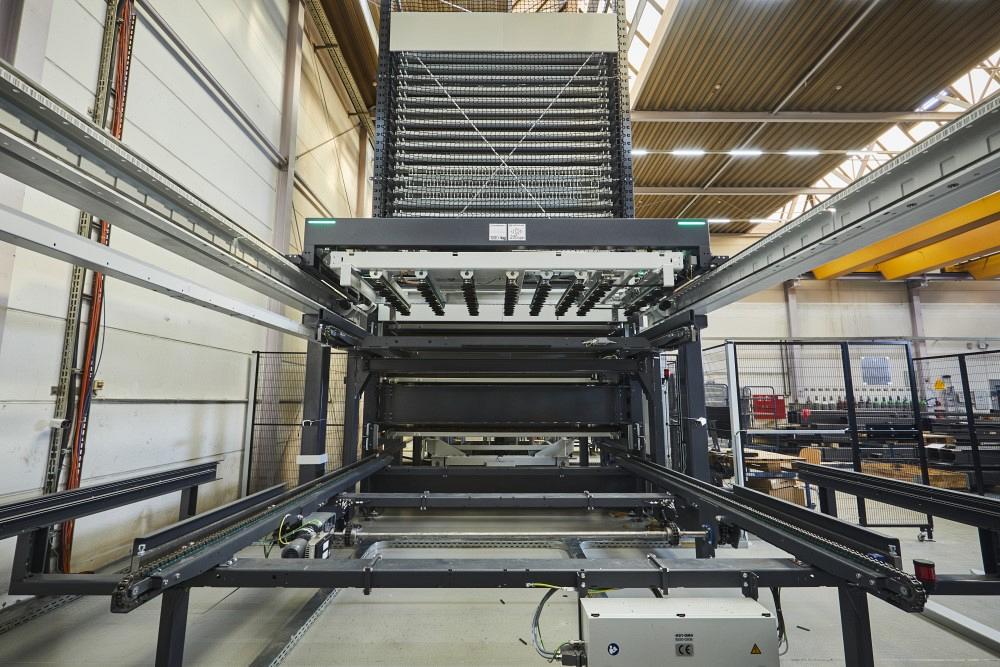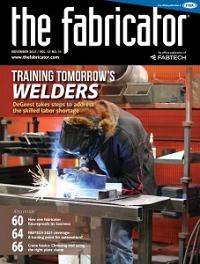Senior Editor
- FMA
- The Fabricator
- FABTECH
- Canadian Metalworking
Categories
- Additive Manufacturing
- Aluminum Welding
- Arc Welding
- Assembly and Joining
- Automation and Robotics
- Bending and Forming
- Consumables
- Cutting and Weld Prep
- Electric Vehicles
- En Español
- Finishing
- Hydroforming
- Laser Cutting
- Laser Welding
- Machining
- Manufacturing Software
- Materials Handling
- Metals/Materials
- Oxyfuel Cutting
- Plasma Cutting
- Power Tools
- Punching and Other Holemaking
- Roll Forming
- Safety
- Sawing
- Shearing
- Shop Management
- Testing and Measuring
- Tube and Pipe Fabrication
- Tube and Pipe Production
- Waterjet Cutting
Industry Directory
Webcasts
Podcasts
FAB 40
Advertise
Subscribe
Account Login
Search
Automation for remnant management in laser cutting
Manual handling isn’t the only option for sheet metal handling processes
- By Tim Heston
- November 16, 2021
- Article
- Materials Handling
A flexible manufacturing system at work, with material towers connected to one or multiple lasers or other cutting machines, is a symphony of material handling automation. Material flows from tower cassettes to the laser cutting bed. Cutting commences just as the cut sheet from the previous job emerges.
Dual forks lift and remove the sheet of cut parts and transport it for automated sorting. In the most advanced setups, mobile automation—either automated guided vehicles (AGVs) or autonomous mobile robots (AMRs)—retrieve the parts and move them on to bending.
Walk to another section of the plant and you don’t see a soaring, synchronous symphony of automation. Instead, you see teams of workers dealing with a necessary evil that metal fabricators know all too well: sheet metal remnants.
Bradley McBain is no stranger to this conundrum. As managing director at MBA Engineering Systems, McBain is the U.K. representative for (among other machine brands) Remmert, a German company that manufactures sheet metal cutting automation equipment that’s machine brand-agnostic. (Remmert sells directly in the U.S.) Multitower systems might serve several laser cutting machines, a punch, even a plasma cutter. Flat sheet towers even can be combined with Remmert’s tube handling honeycomb towers that deliver tube to tube lasers.
At the same time, McBain works with fabricators in the U.K. that deal with remnants. Occasionally he might see an operation that organizes remnants carefully, storing them vertically for easy access. These high-mix operations work to get what they can out of the material they have. That’s not a bad strategy in a world of high material prices and supply chain uncertainties. And with remnant tracking in nesting software, along with the ability of laser operators to “drop in” certain parts right on the laser cutting machine control, programming cut programs on remnants isn’t too arduous a process.
That said, operators still need to physically handle the remnant sheet. It isn’t a lights-out, unattended affair. For this reason and others, McBain sees many fabricators taking a different approach. Because remnants are just too costly to manage, cutting machine programmers use filler parts to fill out a nest and achieve high material yields. Of course, this builds up work-in-process (WIP), which isn’t ideal. And in some operations, there’s a not-so-small chance that the extra WIP won’t be needed. For this reason, many cutting operations simply send remnants to the scrap pile and just deal with less-than-ideal material yields.
“The remnants, or oddments, typically go to waste,” he said. “In some situations, if you have a large remnant left after cutting, it would be picked out and put in a rack manually to be used at some later date.”
“In today’s world, this makes neither ecological nor economic sense,” said Stephan Remmert, owner and managing director of Remmert, in a September press release.
It doesn’t have to be this way, though. McBain described the latest iteration of Remmert’s LaserFLEX automation platform, which incorporates an automated remnant handling technology. After parts are offloaded, the remnant isn’t thrown away but instead sent back to the storage system cassette.
As McBain explained, to maintain reliable operation, the remnant system handles squares and rectangles down to 20 by 20 in. Smaller than that, and the remnants can’t be placed back into the storage cassettes. It also cannot handle remnants with doglegs or other irregular shapes, nor can it manipulate loose web sections of empty skeletons.

The central control of the Remmert system directs the management and logistics of the remaining sheet metal. An integrated warehouse management system manages the total stock, including remnants.
“A lot of lasers these days have destruction-cut and material-cutoff sequences,” McBain said. “It’s a fairly common feature among most [laser cutting machine] manufacturers.”
The laser cuts the nest and then performs a skeleton-destruct sequence on pieces protruding from the remnant so that the remaining piece is either square or rectangular. The sheet then is transported to part sorting. Parts are removed, stacked, and the remnant is sent back to a specified storage cassette.
System cassettes can be assigned various roles, depending on the operation’s needs. Some cassettes could carry uncut stock exclusively, others could have a remnant stacked on top of uncut stock, and still others could act as buffers dedicated to holding a remnant until the next job that requires it comes up.
If current demand calls for sheets with numerous remnants, the operation can assign a few more cassettes as buffers. If a job mix changes to where fewer nests have remnants, then the operation can reduce the number of buffer cassettes. Alternatively, a remnant could be stored on top of raw stock. The system is designed to have one remnant stored per cassette, whether that cassette is designated to be a buffer or whether it holds one remnant on top of full sheets.
“The operator needs to choose whether to store [remnants] back on top of raw material or into another cassette,” McBain explained. “If, however, the remnant is not required for the next material call, then the system will move it out of the way to access full sheet stock … Each time a remnant is returned to [storage], the system is updated with sheet size and location, so the programmer can see stock availability for the next job.”
With the right programming and material storage strategy, the system can add automation flexibility to remnant management. Consider a high-product-mix operation that has a production department for high volumes and a separate department for low volumes and prototypes.
That low-volume area still relies on manual but organized remnant management, with racks that store sheets vertically, each remnant with unique identifiers or even bar codes. Remnant nests can be programmed ahead of time, or (if the control allows it) parts can be inserted directly at the machine control, with the operator using a drag-and-drop touch interface.
In the production area, flexible automation shows its full potential. Programmers assign buffer cassettes and adapt cassette utilization depending on the job mix. Sheets are cut so that a rectangular or square remnant remains, which is then stored automatically for subsequent jobs. Because remnants are handled automatically, programmers are free to nest always with maximum material utilization in mind, with less need to produce filler parts. Almost all parts are sent directly to the next operation, be it at the press brake, panel bender, folder, welding station, or anywhere else.
The automated portion of this operation wouldn’t employ many material handlers, but the few workers it does have wouldn’t be mere button-pushers either. They’d learn new microtabbing strategies, perhaps connecting groups of small parts together so that a part-picking suction unit could lift them out all at once. Programmers would need to manage kerf widths and perform strategic skeleton-destruct sequences in tight corners so that part takeout automation occurs without a hitch. They’d also know the importance of slat cleaning and general maintenance. The last thing they want is for the automation to halt because a sheet becomes inadvertently welded to the piles of slag on the toothed slats underneath.
With everyone playing their part, the symphony of material movement begins, in tune and on time. The fabricator’s automated cutting department becomes a reliable headwater of part flow, always producing what’s needed at the right time, with maximum material yield even in a high-product-mix environment.
Most operations haven’t reached such levels of automation. All the same, innovations in remnant management could bring sheet metal cutting much closer to this ideal.
About the Author

Tim Heston
2135 Point Blvd
Elgin, IL 60123
815-381-1314
Tim Heston, The Fabricator's senior editor, has covered the metal fabrication industry since 1998, starting his career at the American Welding Society's Welding Journal. Since then he has covered the full range of metal fabrication processes, from stamping, bending, and cutting to grinding and polishing. He joined The Fabricator's staff in October 2007.
subscribe now

The Fabricator is North America's leading magazine for the metal forming and fabricating industry. The magazine delivers the news, technical articles, and case histories that enable fabricators to do their jobs more efficiently. The Fabricator has served the industry since 1970.
start your free subscription- Stay connected from anywhere

Easily access valuable industry resources now with full access to the digital edition of The Fabricator.

Easily access valuable industry resources now with full access to the digital edition of The Welder.

Easily access valuable industry resources now with full access to the digital edition of The Tube and Pipe Journal.
- Podcasting
- Podcast:
- The Fabricator Podcast
- Published:
- 04/16/2024
- Running Time:
- 63:29
In this episode of The Fabricator Podcast, Caleb Chamberlain, co-founder and CEO of OSH Cut, discusses his company’s...
- Trending Articles
AI, machine learning, and the future of metal fabrication

Employee ownership: The best way to ensure engagement

Steel industry reacts to Nucor’s new weekly published HRC price

Dynamic Metal blossoms with each passing year

Metal fabrication management: A guide for new supervisors

- Industry Events
16th Annual Safety Conference
- April 30 - May 1, 2024
- Elgin,
Pipe and Tube Conference
- May 21 - 22, 2024
- Omaha, NE
World-Class Roll Forming Workshop
- June 5 - 6, 2024
- Louisville, KY
Advanced Laser Application Workshop
- June 25 - 27, 2024
- Novi, MI



























